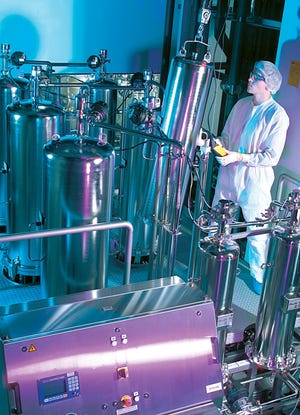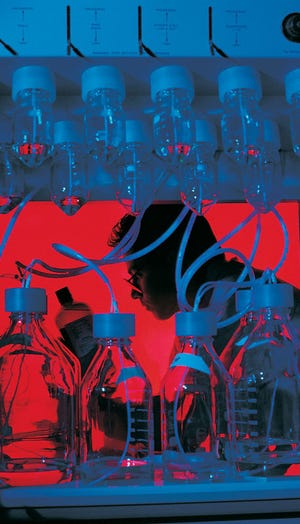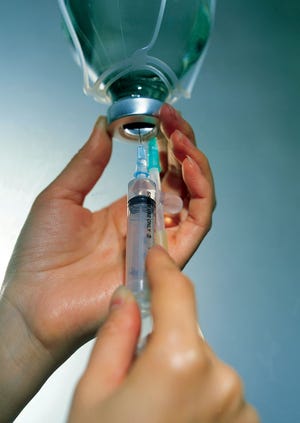Now in its 11th year, the BioProcess International Conference and Exhibition is the industry’s number-one event. At BPI you can make new connections in the field while strengthening current relationships. Network with the advisory committee and speakers, meet key industry contacts, share new ideas with poster presenters, and discover new technologies from exhibitors and sponsors. Participate in interactive sessions and discussions. This year’s program offers multiple new formats for sharing information and ideas.
Networking:
Join the
partnering360 online network
for access to a year-round knowledge exchange and life-science community. Once registered, you get additional access to an event-specific networking tool for scheduling meetings with potential partners before, during and following this event. At the conference, you can choose from 63 case studies and 65 new-data presentations by industry experts and thought leaders, 85% of whom are new to this year’s program.
The Producers Speak
BPI’s marketing...
In literature and music, a keynote establishes the main underlying theme of a work of art. Think of the famous “da-da-da-DUM” in Beethoven’s 5th Symphony. Or in George Orwell’s Animal Farm: “All animals are equal, but some animals are more equal than others.” Similarly, a keynote address establishes the framework for program of events or convention agenda. Frequently the keynote speaker sets the underlying tone and summarizes the core message or most important revelation of an event. Some famous keynote speeches in the United States have been made at party conventions during Democratic and Republican presidential campaigns. Keynote speakers at these events have often gained nationwide fame and/or notoriety.
Over its first decade, the BPI Conference hosted a number of keynote speakers who gave their own memorable addresses. We list them here along with the companies they represented at the time.
In October 2004, Geoffrey F. Slaff (Amgen), Ken Taksen (Pfizer), James N. Thomas (Amgen), and Patrick Y. Yang (G...
What’s on the minds of groups involved in cell culture and fermentation in 2014? They want to build on recent achievements in reducing timelines and cost-of-goods (CoGs) while increasing efficiency and productivity by implementing potentially disruptive approaches and technologies. Those include genomic tools and synthetic biology, continuous bioprocessing, single-use applications, process intensification, raw-material integrity test methods, culture media optimization approaches, technology transfer, and small-scale models.
Raw Materials Matter:
Culture media, supplements, and related ingredients are important raw materials in both cell culture and fermentation processes. Many speakers this year are focusing on the “nice-to-have” and “need-to-have” information from suppliers — who face some challenges in providing the data that users need.
In media and feed formulation optimization, many companies are revisiting the powder/liquid supply question. Determining and meeting quality standards involve analyti...
What’s on the minds of groups involved with downstream processing in 2014? They want to capitalize on innovations in methodologies, materials science, and technologies to help optimize efficiencies. They’re using process design and flexibility in downstream processing to purify an emerging wave of antibodies and novel product modalities. They’re interested in disruptive harvest-step technologies, new chromatography chemistries, continuous processing and the interface between upstream and downstream, high-throughput technologies and modeling, sequence variant analysis, and improving flexibility and facility fit.
Innovative Techniques:
Advances in materials science are offering new opportunities in downstream bioprocessing. Innovations in chemistries, supports, and instrumentation are taking chromatography to new heights. Some new methods don’t even use columns! And several new technologies — such as precipitation, acoustic-wave clarification, and chromatin removal methods that will be discussed this year ...
What’s on the minds of leaders involved in manufacturing and operations strategy in 2014? They want to maximize efficiencies and cost savings across their manufacturing networks by implementing potentially disruptive technologies, operational excellence and new facility concepts. But they also have to be flexible to the production needs of diverse pipelines in a multiproduct environment. New concepts in biomanufacturing can help companies reach those goals through technology transfer, scale-up/scale-down, continuous manufacturing, single-use applications, and possibly relaxing some biomanufacturing facility environmental controls.
The
BioPhorum Operations Group
(BPOG) is a consortium of senior leaders (500 representatives from 18 member companies) of the biopharmaceutical industry. They come together to share and discuss emerging trends and challenges facing their industry and establish best practices for a wide range of biotech drug-substance operations. This year, the group has spearheaded a session h...
What’s on the minds of analytical and quality laboratories in 2014? They want to stay abreast of both emerging analytical tools for biotherapeutics and increasing quality expectations. They need to optimize their analytical strategies and reduce quality risk across every product’s life cycle. They’re focusing on physiochemical characterization methods, impurities and product variants, biosimilars and complex glycoproteins, high-throughput methods for predicting stability and developability of early stage products — and of course, quality risk management.
Characterization, Structure, and Function:
As is often the case, analytical and formulation laboratories have a lot in common. Especially at early stages of product development, the data they gather are complementary, and the methods they involve are often very similar, if not identical. So this year, you’ll see quite a bit of overlap between the quality and analytical and the formulation and delivery conference tracks.
Mass spectrometry and spectroscopi...
What’s on the minds of biopharmaceutical formulators in 2014? They want to apply innovative technologies and phase-appropriate strategies for preformulation and formulation development of monoclonal antibodies (MAbs), next-generation biologics, non-MAb protein therapeutics, vaccines, biologics, and other product modalities. They need to be aware of the latest drug delivery options. High-throughput analytical methods are helping in preformulation and liability assessments. Stability testing and physiochemical characterization remain key.
Product Characterization:
As is often the case, analytical and formulation laboratories have a lot in common. Especially at early stages of product development, the data they gather are complementary and the methods they use are often very similar if not identical. So this year, you’ll see quite a bit of overlap between the quality and analytical and the formulation and delivery programs.
“Analytical testing is a key element of control strategy for manufacturing and relea...
Cell Culture and Upstream Processing
Lewis Ho (Bioreactor Sciences)
Case Studies of hERG Membrane Protein and Japanese Encephalitis Virus Production Using a New, Innovative, Moving-Bed Bioreactor
Human erythroblast-transformation– related gene (ERG) membrane protein has gained great interest as a target for drug discovery. A doubled expression of the hERG gene was induced under nutrient limitations. The protein is membrane bound, so whole-cell recovery from the carriers is required. HEK293 cells were used. A Japanese encephalitis virus (JEV) vaccine has long been the only reliable solution to prevent this deadly disease. However, the virus is unstable. Postinfection conditions are critical for optimal virus production and recovery. We use those two case studies to illustrate a new innovative moving-bed (MB) bioreactor’s unsurpassed versatility and functionality to accommodate specific desired conditions and accomplish the entire upstream process in one unit. The mobility of the moving matrix bed allows fo...











